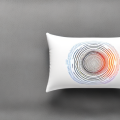The practice of foam rolling has become increasingly popular among athletes and fitness enthusiasts. Foam rolling is a self-massage technique that uses a cylindrical foam roller to apply pressure to your muscles, aiding in muscle recovery and increasing flexibility. Vibrating foam rollers have also emerged as a popular alternative, providing the same benefits as regular foam rollers with the addition of vibrations. In this article, we’ll explore the differences between regular and vibrating foam rollers and the benefits of each.
What is Foam Rolling?
Foam rolling is a self-myofascial release technique used to loosen up tight muscles and trigger points. It involves rolling a foam cylinder over various parts of your body, such as your legs, back, and arms. This technique has been shown to improve mobility, flexibility, and range of motion, decrease soreness and improve post-workout recovery time.
Foam rolling can also be used as a form of injury prevention. By regularly foam rolling, you can help prevent muscle imbalances and reduce the risk of injury during physical activity. Additionally, foam rolling can be a great way to warm up before a workout, as it increases blood flow to the muscles and prepares them for exercise. Overall, foam rolling is a simple and effective way to improve your physical health and performance.
What is Vibrating Foam Rolling?
Vibrating foam rollers are the same cylindrical foam rollers found in regular foam rolling, but they have a vibrating mechanism built-in that provides additional benefits. The vibrations allow for increased muscle activation and relaxation, which can help loosen tight muscles more effectively, reduce lactic acid buildup, and aid in post-workout recovery time.
Additionally, vibrating foam rolling can also improve blood circulation and increase flexibility. The vibrations help to stimulate blood flow to the muscles, which can aid in the delivery of oxygen and nutrients to the muscles, promoting faster recovery and reducing the risk of injury. The increased flexibility can also help to improve range of motion and reduce muscle soreness.
The Science Behind Foam Rolling
The science behind foam rolling is simple, yet effective. When you apply pressure to the muscle, the myofascial tissue, or connective tissue, is manipulated through compression. This compression helps to improve mobility and flexibility by improving circulation, releasing tension, and decreasing the risk of injury.
Additionally, foam rolling has been shown to have a positive effect on muscle soreness and recovery. By increasing blood flow to the muscles, foam rolling can help to reduce inflammation and promote healing after a workout. It can also help to break up scar tissue and adhesions, which can improve range of motion and reduce pain. Regular foam rolling can be a valuable tool for athletes and anyone looking to improve their overall physical health and well-being.
How Vibrating Foam Rolling Differs from Regular Foam Rolling
As previously mentioned, the primary difference between regular foam rolling and vibrating foam rolling is the addition of vibrations. These vibrations serve to increase blood flow, improve oxygenation, and decrease inflammation. Additionally, the vibrations allow for more efficient muscle activation and relaxation, providing a deeper massage and greater benefits compared to regular foam rolling.
Another key difference between vibrating foam rolling and regular foam rolling is the level of intensity. Vibrating foam rollers typically have multiple speed settings, allowing users to adjust the intensity of the vibrations to their preference. This can be especially beneficial for individuals with sensitive muscles or injuries, as they can start with a lower intensity and gradually increase as their muscles become more accustomed to the vibrations. Regular foam rollers, on the other hand, provide a consistent level of pressure throughout the rolling process.
Benefits of Regular Foam Rolling
Regular foam rolling has a wide range of benefits, including increased mobility and flexibility, improved circulation, reduced muscle soreness, and increased range of motion. By applying pressure to your muscles, foam rolling can also help to break down adhesions and tight spots in the tissue, allowing for greater range of motion and overall physical health. Additionally, foam rolling has been shown to improve muscle recovery time, making it an effective tool for athletes and fitness enthusiasts alike.
Another benefit of regular foam rolling is that it can help to prevent injuries. By using a foam roller to target specific muscle groups, you can improve their flexibility and reduce the risk of strains and sprains. Foam rolling can also help to improve your posture and alignment, which can further reduce your risk of injury during physical activity. Incorporating foam rolling into your regular exercise routine can help you to stay injury-free and perform at your best.
Benefits of Vibrating Foam Rolling
The primary benefit of vibrating foam rollers is the addition of vibrations. These vibrations not only provide a more intense massage, but they also allow for increased muscle activation and relaxation, allowing for more effective muscle recovery and decreased muscle soreness. Additionally, the increased blood flow and oxygenation can help to reduce inflammation and improve overall physical health.
Which is Better: Regular or Vibrating Foam Rolling?
While both regular and vibrating foam rollers have their benefits, there is no clear answer as to which is better. Ultimately, it comes down to personal preference and individual needs. If you are new to foam rolling, starting with a regular foam roller may be a good choice. However, if you are experienced and looking for a more intense massage with greater benefits, a vibrating foam roller may be the way to go.
Factors to Consider When Choosing a Foam Roller
When choosing a foam roller, there are a few factors to consider. The first is size, as different sizes of foam rollers are better suited for specific muscle groups. A 36-inch foam roller is ideal for larger muscle groups like the back and legs, while a 12-inch foam roller is better for smaller muscle groups like the calves and arms. The second factor is density, with softer foam rollers better suited for beginners and firmer foam rollers suited for more experienced users. Finally, consider the additional features, such as vibration or textured surfaces, to find the best fit for your needs.
How to Incorporate Foam Rolling into Your Fitness Routine
Foam rolling can be incorporated into your fitness routine in a variety of ways. A great way to start is by incorporating foam rolling into your warm-up and cool-down routines. This will help to prime your muscles for exercise and aid in post-workout recovery. Additionally, you can use foam rolling as a standalone practice, focusing on specific muscle groups and engaging in a dedicated foam rolling session. Regardless of how you choose to incorporate foam rolling, be sure to start slowly and listen to your body to avoid injury.
Tips for Safe and Effective Foam Rolling
To foam roll safely and effectively, there are a few tips to keep in mind. Firstly, focus on one muscle group at a time, and never roll directly on a joint. Additionally, maintain good posture and avoid rolling over bony areas to prevent injury. Finally, roll slowly and breathe deeply, taking time to target specific areas of tightness and tension.
Conclusion: Choosing the Right Type of Foam Roller for Your Needs
Ultimately, whether you choose a regular or vibrating foam roller, the benefits of foam rolling are clear. By incorporating foam rolling into your fitness routine, you can improve mobility, flexibility, and overall physical health. Be sure to start slowly, listen to your body, and choose the best foam roller for your individual needs and preferences.





